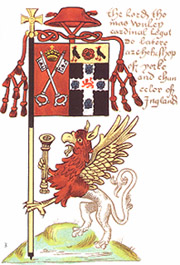Banner
Banner refers to a long strip of cloth or flag bearing a symbol, logo, slogan, or other messages. Banners are used for various purposes, including advertising, protests, celebrations, and identification. They have been utilized throughout history in many cultures around the world for both secular and religious occasions. The design and usage of banners have evolved over time, adapting to the needs of the era while still serving as a powerful means of communication and expression.
History[edit | edit source]
The use of banners dates back to ancient times. In Ancient Rome, banners were used in military contexts to identify units and for ceremonial purposes. These early banners, known as vexilloids, were symbols of power and authority. In medieval Europe, banners played a crucial role in battles, serving as rallying points for knights and soldiers. The design of these banners often featured heraldic symbols, which were unique to the individual or family they represented.
Types of Banners[edit | edit source]
There are several types of banners, each serving different purposes:
- Advertising Banners: These are used by businesses and organizations to promote products, services, or events. They can be found in various formats, including digital displays, hanging banners, and stand banners.
- Protest Banners: Utilized during demonstrations and protests, these banners carry messages advocating for social, political, or environmental causes.
- Celebratory Banners: Used in public and private celebrations such as birthdays, weddings, and anniversaries. They often feature congratulatory messages and decorative elements.
- Web Banners: Digital banners displayed on websites. They can be used for advertising, navigation, or as part of the website's design.
Materials and Design[edit | edit source]
Traditional banners were typically made of cloth or paper, with messages painted or embroidered onto them. Modern banners, however, can be made from a variety of materials, including vinyl, fabric, and mesh. The choice of material often depends on the banner's intended use, particularly in terms of durability and visibility.
The design of a banner is crucial to its effectiveness. It must convey its message clearly and be visually appealing to attract attention. The use of colors, fonts, and images must be carefully considered to ensure the banner's message is communicated effectively.
Cultural Significance[edit | edit source]
Banners hold significant cultural and symbolic meanings in many societies. In religious contexts, banners are used in processions and ceremonies to symbolize faith and devotion. In sports, banners are used to show team support and celebrate achievements. They also play a role in community events, such as festivals and parades, where they contribute to the sense of identity and unity.
Conclusion[edit | edit source]
Banners are a versatile and enduring form of communication. Their ability to convey messages visually and their adaptability to various contexts have made them an essential tool for expression across cultures and throughout history. Whether used for advertising, protest, celebration, or identification, banners continue to be a powerful symbol of expression and communication.
This communication related article is a stub. You can help WikiMD by expanding it.
Search WikiMD
Ad.Tired of being Overweight? Try W8MD's physician weight loss program.
Semaglutide (Ozempic / Wegovy and Tirzepatide (Mounjaro / Zepbound) available.
Advertise on WikiMD
|
WikiMD's Wellness Encyclopedia |
| Let Food Be Thy Medicine Medicine Thy Food - Hippocrates |
Translate this page: - East Asian
中文,
日本,
한국어,
South Asian
हिन्दी,
தமிழ்,
తెలుగు,
Urdu,
ಕನ್ನಡ,
Southeast Asian
Indonesian,
Vietnamese,
Thai,
မြန်မာဘာသာ,
বাংলা
European
español,
Deutsch,
français,
Greek,
português do Brasil,
polski,
română,
русский,
Nederlands,
norsk,
svenska,
suomi,
Italian
Middle Eastern & African
عربى,
Turkish,
Persian,
Hebrew,
Afrikaans,
isiZulu,
Kiswahili,
Other
Bulgarian,
Hungarian,
Czech,
Swedish,
മലയാളം,
मराठी,
ਪੰਜਾਬੀ,
ગુજરાતી,
Portuguese,
Ukrainian
Medical Disclaimer: WikiMD is not a substitute for professional medical advice. The information on WikiMD is provided as an information resource only, may be incorrect, outdated or misleading, and is not to be used or relied on for any diagnostic or treatment purposes. Please consult your health care provider before making any healthcare decisions or for guidance about a specific medical condition. WikiMD expressly disclaims responsibility, and shall have no liability, for any damages, loss, injury, or liability whatsoever suffered as a result of your reliance on the information contained in this site. By visiting this site you agree to the foregoing terms and conditions, which may from time to time be changed or supplemented by WikiMD. If you do not agree to the foregoing terms and conditions, you should not enter or use this site. See full disclaimer.
Credits:Most images are courtesy of Wikimedia commons, and templates, categories Wikipedia, licensed under CC BY SA or similar.
Contributors: Prab R. Tumpati, MD





